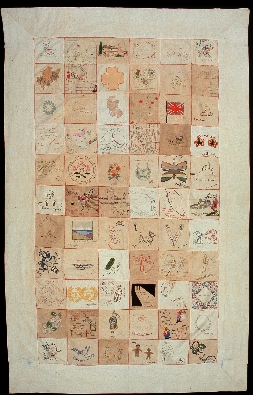Quilt No.937AWM - Australian War Memorial

This quilt is one of 2 signature quilts made by some of the 400 civilian internees in Changi Prison during the first 6 months of their captivity, from March 1942. They were made for the Australian Red Cross and the Japanese equivalent and are at the Australian War Memorial. A third quilt is held by the British Red Cross. It was hoped that the Japanese Red Cross quilt might sway their captors to send the first quilt to Australia. However the authorities returned both quilts to Colonel Collins the senior medical officer, who gave them to Colonel R.M.Webster the medical officer in charge of the Australians at the hospital at Kranji, with the request that one should go to the Australian Red Cross and the other to Colonel Webster's wife. Both were donated to the Australian War Memorial, the latter in 1968 by Mrs. Webster.
The quilts were the idea of a Canadian internee, Mrs. Ethel Mulvaney, who had been a Red Cross representative in Singapore. Making the quilts was designed to alleviate boredom, boost morale and pass information to men in other camps. Each woman was asked to put something of herself into her square. As a result some squares contain quite obvious messages and others are purely decorative.
From 66 squares the work of only 4 Australian women are represented: Dr. Margaret Smallwood, Sheila Allen, Judy Good and Helen Loxton.
"It is likely that a quilt was made for the Australian Red Cross not because there were many Australian internees, but because it was assumed that the Australian Red Cross would play a major part in supplying aid to Singapore and POWs in Asia. In the event the Japanese blocked the distribution of Red Cross parcels from Australia."
[Australian War Memorial]
Related Quilts:
1956 x 1677mm
1800 x 1170mm
1880 x 1850mm
2540 x 2490mm
3049 x 2109mm
2760 x 2350mm






